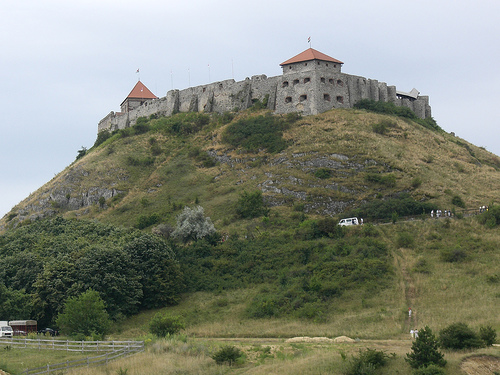

Location: Sumeg, Veszprém county Map
Constructed: 13th century
Tel. (087) 55 02 76
Apr- Sept: 10 am- 6 pm
Sumeg Castle is located in Sumeg, Veszprém county of Hungary. Castle hill that rises at 885 feet (270 meters) has been inhabited since the Roman times. Roman legions first erected wooden fortress here to defend their empire against raiding Germanic tribes. Sumeg Castle was build here in the 13th century and subsequently almost completely reconstructed in the 16th century. Sumeg citadel is also a museum of Medieval life. Re- enactments of battles and jousts are held here in summer months of the year. Besides here you can find restored fortune chambers with authentic weapons of trade, collection of weapons, couches and other exhibitions. Traditional dances are also held here every year. One of the town’s main attractions is the Roman Catholic Church of Ascension build in 1756- 58 on Biro Maron utca (street). Beautiful frescoes of Austrian Franz Anton Maulbertesch adore walls of the church inside Sumeg Castle.
Church of Ascension
 '
'
History
ARC. By order of King Béla, the bishop of Veszprém
erected a strong stone castle on the hill of Sümeg. At the beginning
of the 14th century, the oligarchs of Transdanubia, the Kőszeg
family, seized the power of unlimited power, and their rule was
decided only by Károly Anjou in the victorious campaign of 1318. In
the summer of 1440, the nobles of Queen Elizabeth of Luxembourg
besieged the castle of Sümeg, part of the bishopric belonging to
King Ulászló's camp, which, however, was successfully defended by
the guards. The outer castle was soon built, making Sümeg the
strongest stone castle in the area. The significance of Sümeg was
only enhanced by the fact that the bishop of Veszprém also withdrew
from his seat here, which was occupied in 1552 by the "pagan"
armies. In 1553, its most modern fortification, the multi-storey,
thick-walled Kövess bastion, was erected. In the spring of 1605, the
Transylvanian noble army of István Bocskai, who rose up against the
tyranny of the Habsburg House, occupied the castle, where Miklós
Újlaky, Bishop of Veszprém, was assassinated, and then his head was
lowered on the hillside. The military role of the II. He also kept
it in the Kuruc war of independence, led by Ferenc Rákóczi, and from
1705 it was considered an important base for the insurgents, and
even gunpowder was produced for the fighting army within its walls.
With the decline of their luck in 1709, the Kuruc army, led by
István Török from Telekesi, gave up without a cannon shot (the
buildings of the castle were set on fire under the pretext of a
military exercise four years later). On January 23, 1707, as István
Török of Telekesi, the commander of the castle of Sümeg, resigned
from his position, Count Antal Esterházy entrusted István Egerváry,
László Palásthy and Mihály Sidy to the Sümeg commandant (castle
command).
The defenseless fortifications were destroyed by
the iron teeth of the weather, along with the population, for
centuries, until the archaeological excavation and preservation that
began in the 1960s began. In the best restored medieval stone castle
of the Balaton Uplands, the lives of the former heroes are evoked
with colorful castle games every summer.
From 2016, the
castle will be renovated under the National Castle Program.
Renovation of the castle within the framework of the National Castle
Program
The castle will be renewed from the European Union
(GINOP-7.1.1-15-2016-00012) from the European Union
(GINOP-7.1.1-15-2016-00012) within the framework of the "Development
of the Sümeg Castle for Tourism" project.
The aim of the
project:
The development of parts of the building corresponding
to the design and placement of new tourist attractions came to the
fore.
It is necessary to create closed spaces for the
presentation of tourism development and the exhibition material.
Connected, interoperable, yet “castle-like” exhibition spaces will
be created, which will have an exciting spatial structure for
visitors.
From an architectural point of view and taking into
account the long-term development, the mass reconstruction of the
buildings in the eastern wing of the castle (barracks, castle house,
medieval kitchen, Csabi Tower) and the construction of the
north-eastern pedestrian walkways will take place.
The uniform
design of the barracks, the castle house, the medieval kitchen
restores the surroundings of the castle; the Csabi Tower provides
the passage between the two wings of the Northeast Passenger Passage
and the exhibition spaces. The construction of the sidewalks from
the east side balances the transfer of the building mass of the new
developments from the core of the castle to the Rendeki Tower, thus
creating a more uniform building block, close to historical
authenticity, yet well used for tourism and cost-effective.